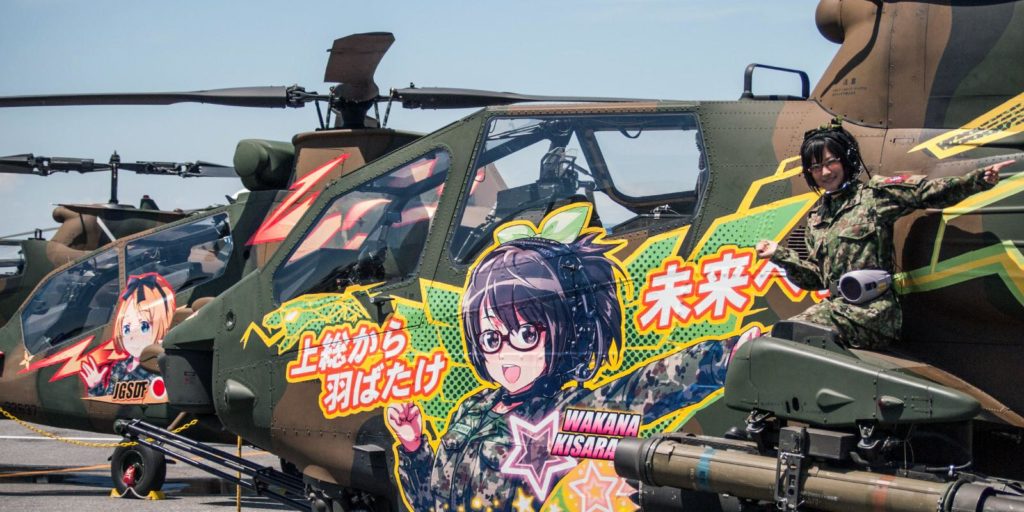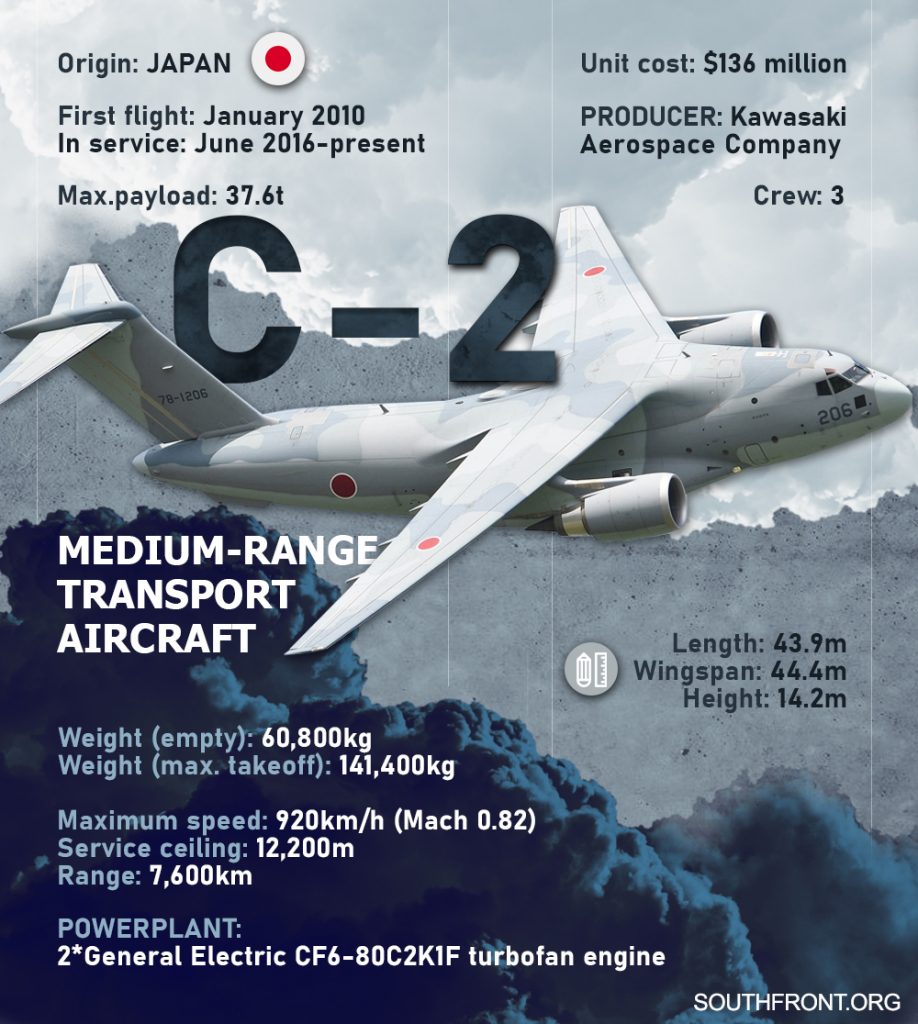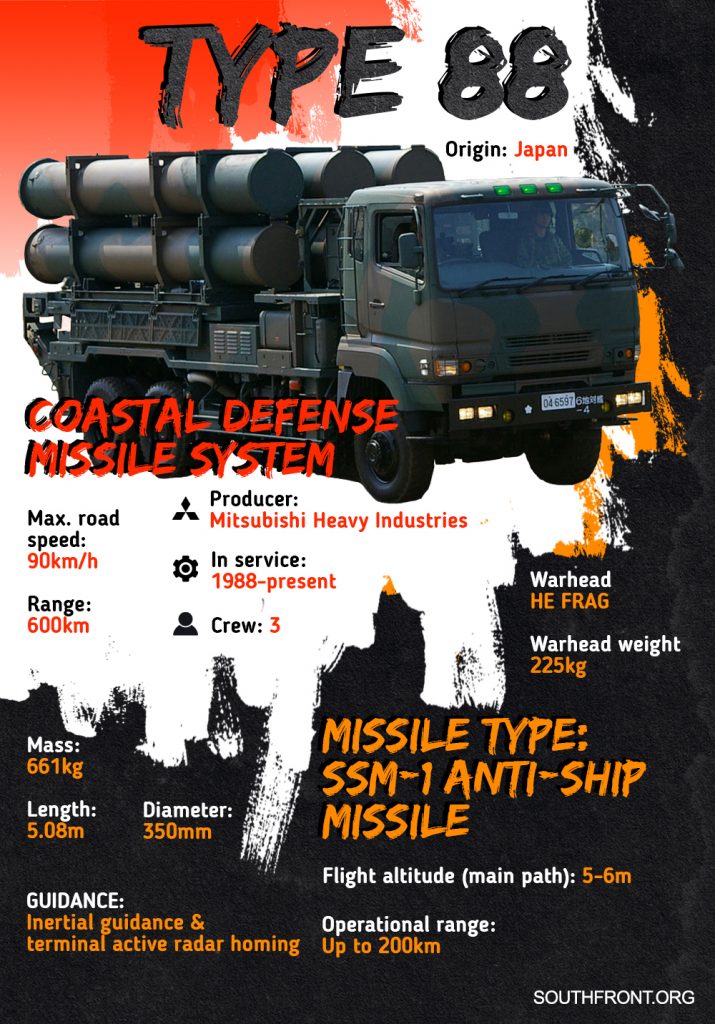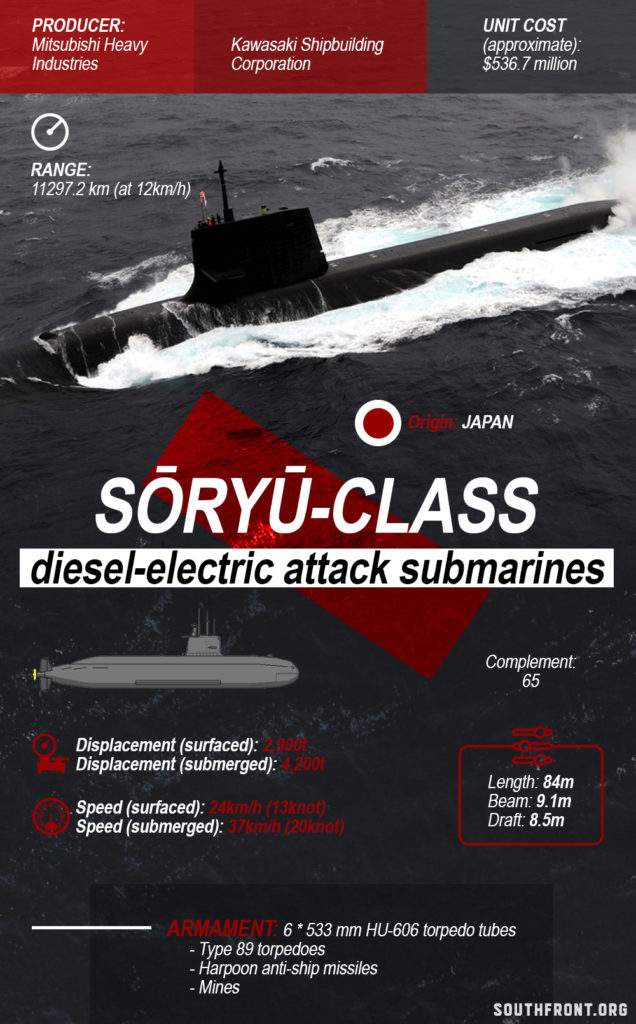
The Eastern Army Flying Corps’ Fourth Anti-Tank Helicopter Squad of Japan’s Self-Defense Forces. Photograph from Monsieur Ashiya/ Flickr
Written by E. Sergeeva; Originally appeared at Foreign Military Review 2021 #1, translated by AlexD exclusively for SouthFront
The development of military production based on modern technology is an indispensable condition for ensuring the military power of the state. In addition, it contributes to the efficiency of the national industry as a whole.
According to Japan’s National Security Strategy, first developed in December 2013, national military production and technology must be developed and improved in order to maintain the nation’s defence capabilities in the face of limited natural resources.
The country’s defence industry is currently a collection of high-technology enterprises integrated into a system of industrial cooperation. It has a complete industrial structure, with the exception of the nuclear industry, and produces armaments and military equipment (AME) of all major types: rocket and space, aviation armoured vehicles and naval equipment, artillery and small arms, radio-electronic equipment and various munitions. There are about 100 enterprises in the country directly attributed to the defence industry.
One of the Japanese government’s economic and military policy priorities is to optimise the acquisition of weapons and military equipment. The Japan Ministry of Defence (MoD) Office of Armaments and Military Equipment is responsible for their development programmes and subsequent equipment of the Self-Defence Forces. It monitors budget spending at all stages of the weapons and military equipment life cycle.
The characteristic features of the country’s military industry at the present stage are as follows:
- the absence of state-owned military enterprises, production of military equipment for the defence ministry by private enterprises;
- diversification of production, availability of dual-use and civilian production capacities;
- concentration of production in large production associations that have the necessary facilities to produce a wide range of military products;
- a well-developed research base;
- broad national military-industrial co-operation, a multi-level system of subcontracting involving a large number of medium and small businesses involved in the manufacture of civilian products;
- conversion and reservation of civilian capacity for military purposes;
- the possibility of reproducing previously produced models;
- the production of the same types of weapons and military equipment in several companies in order to increase the rate of wartime production;
- the development of military-technical cooperation with foreign companies for the licensed production of weapons and military equipment using domestic and foreign components and accessories.
Japan’s largest military-industrial companies include: Mitsubishi Junkogyo, Kawasaki Junkogyo, Ishakawaijima Harima Junkogyo, Mitsubishi Denki, Nippon Denki, Toshiba and Subaru. They are present in most sectors of the country’s defence industry. The production of weapons and military equipment by these companies accounts for about 3% of the total output.
Mitsubishi Junkogyo has facilities in all branches of the military industry and is Japan’s leading manufacturer of armoured vehicles. The range of products from the armoured vehicle industry includes: tanks, heavy armament combat vehicles (HACVs), APCs, anti-aircraft armoured trucks (AAATs), AIFVs, SPGs, engineering and support equipment for various purposes. The main vehicles are type 10 and 90 tanks; type 16 MCTs; type 89 AIFVs; type 73 APCs; 155 mm type 99 and type 75 SPGs; type 87 AAATs.
The company is currently fulfilling a Ministry of Defence order to supply the troops with type 16 MBTs, type 10 tanks and well as type 99 155 mm AAATs.
Aircraft of various classes produced by the company have formed the backbone of Japanese military aviation since the Second World War. Its subsidiaries manufacture, maintain, upgrade and repair F-2, F-4EJ, F-15J fighters, LR-1 reconnaissance aircraft, T-400 military transport aircraft, UH-60J, SH-60K and SH-60J multirole helicopters and fuselage modules for XR-1 and XC-2 aircraft. Komako Minami Kogyo also carries out large-scale assembly of the fifth-generation F-35A fighters, as well as producing individual wing, fuselage, tail and landing gear components. The plant is certified as a maintenance and repair centre for this type of aircraft.
The Nagoya Production Centre produces TS-1 turboshaft engines for the ON-1 attack helicopter and transmission components for the UH-60J, SH-60K and SH-60J multirole helicopters.
Mitsubishi Junkogyo is also one of the leading manufacturers in the military shipbuilding industry. For example, the Kobe plant specialises in the production of the Soryu, Harishio and Oyashio diesel submarines for the national navy. The Nagasaki plant produces the Akizuki and Asahi destroyers equipped with the Aegis Multifunctional Weapons Control System (MLCS), while the Shimonoseki plant produces the Hayabusa missile launchers.
The Mitsubishi Junkogyo in Nagoya produces other types of weapons and military equipment – anti-ship (ASATs), anti-submarine guided missiles and tactical air-to-air missiles.
Kawasaki Junkogyo is considered the second largest manufacturer of military products and has facilities in the country’s aviation, shipbuilding and missile and space industries. Its plants currently have the capacity to manufacture engines and aircraft components: C-1 and C-2 military transport aircraft; P-1, P-2V7 and OR-3S patrol aircraft; T-4 trainer aircraft; OH-1 helicopters, MSN-101, SH-60J, CH-101 and SH-60K multi-purpose helicopters, transport and landing helicopters CH-47J/JA as well as engines for them.
The company is also involved in the US-2 amphibious aircraft and F2A/B fighter aircraft production and modernisation programme.
Kawasaki Jukogyo produces Soryu diesel-electric submarines for the national navy at its Kobe shipyard. It also refurbishes the Oyashio and Harishio submarines.
In addition, the firm’s Kakamigahara facility has the capability to produce 01, 79, 87 and 96 types of ATMGs.
Ishikawajima Harima Jukogyo is a major manufacturer of Japanese aircraft engines (about 70%), including for the Ministry of Defence. The aircraft industry in Mizuho assembles and repairs aircraft and helicopter engines for various applications, such as:
- F-110 turbofan engine for the Japanese F-2 fighter jet;
- F3 turbofan engine for the T-4 training aircraft;
- F7-10 turbofan engine for the P-1 patrol aircraft;
- T700 turboshaft engine for the AN-1 helicopter.
Ishikawajima Harima Jukogyo is involved in the national space programme and develops and manufactures turbo-pump units for rocket engines. Tomioka Kogyo is the final assembly facility for H-IIA/H-IIB medium launch vehicles, M-V light launch vehicles, and S-series research rockets.
The company manufactures components that fully support rocket assembly, in particular: first and second stage engines, including fuel tanks and fuel supply systems; shunting engines; rocket boosters; automatic control systems for shunting jet engines; and pneumatic and hydraulic systems for rockets and space modules.
Subaru produces various types of aircraft and helicopters, including those for the military. In February 2019, the firm handed over to the national armed forces for testing a new helicopter based on the multi-purpose Subaru-Bell 412ERX in collaboration with Bell Helicopter under the UH-X programme.
The company’s aviation plants in Handa and Utsunomiya produce T-5 and T-7 training aircraft, U-125A search and rescue aircraft, unmanned aeroplane and helicopter type drones, as well as airframe components. In addition, there is capacity to produce UH-1J/H multi-purpose helicopters and AH-IS and AH-64 Apache attack helicopters.
The Shinmeiwa Kogyo factory in Kobe produces the US-1A/-2 amphibious aircraft for the navy, while the company’s Tokushima aircraft factory produces the U-36A and U-4 multi-purpose aircraft as well as aircraft fuselage modules.
Japan Marine United is one of the leading companies in the shipbuilding industry. It has extensive experience in the production of ships and vessels of various classes for the Ministry of Defence: training, auxiliary, research, transport, icebreakers, minelayers, minesweepers, destroyers and helicopter destroyers. Its Yokohama plant, for example, is building the Isumo and Shirane helicopter destroyers, Congo destroyers, Aegis destroyers, amphibious assault ships and various naval support vessels. The Maizuru shipyard has facilities for the production of destroyers, frigates, minesweepers, icebreakers, amphibious helicopter ship-docks, research ships and transport ships.
The construction of destroyers, frigates, transport vessels and auxiliary vessels for military purposes has been established at the Mitsui Zosen plant in Tamano.
One of the largest manufacturers of missile weapons is Mitsubishi Denki. Its facilities in Amagasaki and Kamakura manufacture tactical air-to-air missiles, SLCMs, medium- and shot-range SAMs and long-range anti-missiles. The main types of missiles produced are 03 and 93; PAK-Z Patriot; and 99 and 04 air-to-air missiles.
The company is also involved in the manufacture of radio-electronic products, such as:
- aircraft radios for T-4, F-2, F-4EJ, C-130H, F-15, F-4, U-125A, YS-11;
- mobile air defence radars to detect low-flying targets;
- ship’s radar.
Nippon Denki is a major manufacturer of radio-electronic products and has its own R&D and technology centres to carry out full-cycle operations. Its enterprises build radars, radios and other switching equipment, as well as opto-electronic devices:
- universal broadband portable radios;
- universal car radios;
- mobile radio communication complexes;
- aviation radios;
- tropospheric mobile radio communication system J/TRQ-502/-504;
- equipment of stationary and mobile Rapcon J/TPQ-701 complexes;
- equipment of fixed and mobile complexes of the NATO TACAN navigation system;
- J/FRQ-503 tropospheric radio communication complexes;
- ship-based OPS-12 air defence radars;
- the NOLR-6 radio direction-finding equipment;
- mod. 1 mobile radars JTPC-P11 and JTPC-P23;
- three-axis J/TPS-102 (transportable) and J/FPS-2 (stationary) AFAR air defence radars;
- electronic switchgear complexes.
Toshiba is one of the leading companies in the military electronics industry. Its facilities produce radios, radars and command and control centres:
- J/ARC-32 aviation radios;
- JMPQ-P13 mobile radars;
- mobile artillery spotting complexes;
- radar landing systems;
- meteorological radars;
- J/FPS-4 fixed-three axis air defence radars;
- Type 81 SAM portable fire control complexes;
- J/TSC-701 mobile flight control stations.
The Komatsu Seisakusho Machinery Company manufactures armoured vehicles, with its Komatsu plant producing type 96 APCs and armoured vehicles.
Hitachi Seisakusho’s facilities in Tsuchiura and Hitachi have the capacity to build various engineering machines as well:
- 120 mm self-propelled mortars based on the type 96 APC;
- type 87 ammunition supply vehicles;
- type 99 transport and loader vehicles for the US M270 MLRS;
- type 92 bridge-laying tank.
Nihon Siesaku is the largest manufacturer of artillery and gunsmithing products in the Japanese defence industry. Its enterprises produced guns for type 10 tanks, 155 mm guns for type 99 self-propelled howitzers , 76 mm and 127 mm naval artillery installations. Production remains possible for 105 mm guns for type 16 MBTs, 120 mm guns for type 90 MBTs, 35 mm guns for type 87 ACS, type 60 106 mm recoilless guns, FH-70 towed howitzers. The company also manufactures turrets for these types of armoured vehicles, which are supplied to prime contractors for subsequent assembly of finished vehicles.
In terms of the level of development of the scientific, technical and production base, one of the leading branches of the military industry is the shipbuilding industry. It has the capacity to produce all major types of surface ships (except aircraft carriers) and non-nuclear submarines, as well as support vessels for the national armed forces. Most defence shipyards can manufacture, repair and modernise ships and vessels.
The aviation industry, the improvement of which is given considerable attention by the state, is largely capable of meeting the needs of the national armed forces for modern aviation equipment, providing modernisation, repair and maintenance. At present, however, it remains dependent on foreign technology and components.
Japan’s missile and space industries are capable of meeting the needs of the national armed forces for a wide range of rocket weapons and, if necessary, can produce operational-tactical missiles (high-precision missiles with a range of up to 500 km) within a short period of time.
Japan’s insular location and predominantly mountainous terrain mean that armoured vehicles are limited in use throughout the country. However, a well-developed science and technology base allows the industry to be independent of foreign companies in the production of modern armoured vehicles for the national armed forces.
Japan’s artillery and small arms industry as a whole meets the needs of its armed forces with the industry’s products. At the same time, there is close military-industrial cooperation with leading foreign companies.
The radio-electronic industry has the capacity to produce a wide range of military products in sufficient quantities to supply the national armed forces.
The priority areas of Japan’s military and economic policy are preserving the further development of the scientific and technological base for manufacturing advanced weapons and military equipment in order to avoid lagging behind the world’s leading manufacturers, and also to improve the quality of the end product while cutting costs. In addition, the use of civilian sector achievements is being stepped up.
Japan’s existing military-industrial base makes it possible to meet the needs of the national armed forces for a wide range of modern types of weapons and military equipment by 80-90% and accounts for the high production potential of the mobilisation-deployed military industry.
However, there is still considerable dependence on imports of a number of weapons and military equipment and their components, primarily from the USA.









Hey!!!! We have the most sophisticated technology, just don’t want to bother with fights anymore.
japan is pathetic at best
fix japans weird sick society because japan isnt a real power in any sense of the word since its people are a mess
The Chinese shouldn’t forget Nanking 😜
Main use of the Japanese today is to provide comfort boys for American sailors.
Even the military is into itasha. Only in Japan!!!